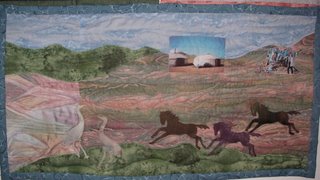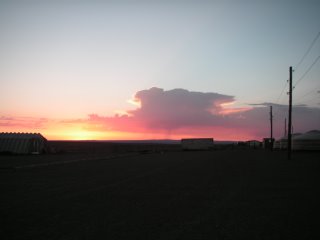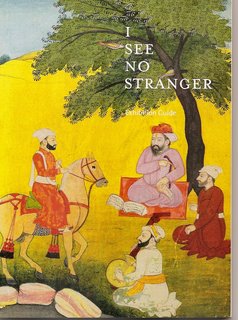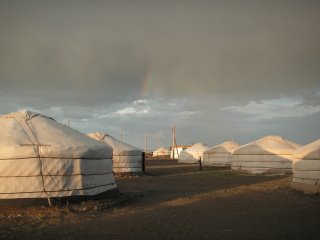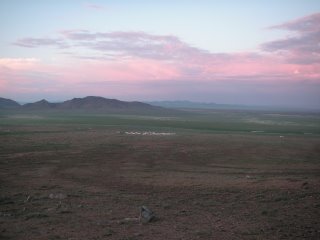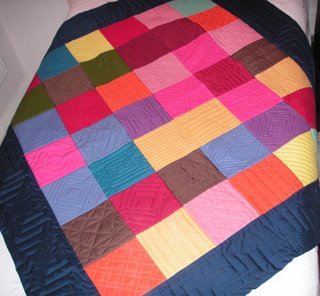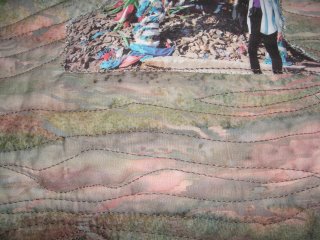
How to quilt the quilt has been on my mind for the past two or three months. I have a quilt started for the Empire Quilters Show next March, and I've been trying to decide how I want it to be quilted -- by me on the machine? By a quilter with a long arm machine? I can do smaller ones by hand and this is not enormous but I know I won't get it done in time by hand. So ... well so far I don't know if it's going to look like the picture in my mind which includes appliques on top of the already quilted piece ... sounds dumb, huh? Maybe it is, I haven't got far enough to see if it's going to work the way I'm envisioning.
Meanwhile, the whole matter of quliting has been muddying my mind. I've been watching trends and reacting, I realize. That realization came to me as I did the Steppes quilt that I wrote about a few entries ago. Above is a picture of a section of it; I quilted fairly heavily, in waves and swirls that seemed to echo the way I perceived the landscape when I drove through it or sat on a hilltop eating lunch and feeling I was melting into the undulating hiills. This quilting is not "free motion". I'm not sure I can do free motion on my sewing machine. I haven't taken a class because I fear my machine is too old.
To digress: I have a Japanese-made Riccar bought over 40 years ago. It has no plastic parts, it's supposed to be portable but weights a good 50 pounds. Only one part has broken in all those years -- the foot lift lever. It's sewn at least a million miles of seams, counting many, many garments and 30 or so years of quilting. Every so often I look at magnificent machines that do many things electronically and think, ahhh what I could do with that! ... Then I look at the price tag and I think, but I could go to Sri Lanka, or New Zealond or Terra Del Fuego for the same amount. And when it comes to choices, I'll chose travel as long as I'm physically able -- which I hope will be a very long time yet.
I've been watching fashions change in the quilting world. Those who read quilting history know that quilters are "early adopters". As soon as sewing machines became available women began using them. The blizzard of new gadgets and devices and techniques invented in the last 15 or 20 years have been fantastic and received with enormous enthusiasm. In the last five years I've noticed a great change in the amount and style of quilting on the quilts in shows. And I notice it myself in my work.

This is another memory quilt. Artistically it is less successful than the Steppes quilt. It show three photo transfers of me in the Himalayas on the way to a high pass complete with prayer flags and the Annapurnas in the background. The other fabrics are "mountainous". It's been hanging in my entry hall for four or five years and I love being reminded of trekking in the Nepalese sub-kingdom of Mustang. I was the oldest in the group and the last up to every pass. But I did it!! This quilt reminds me how much I loved that journey. ... However the quilting on it is very sparse, certainly compared to the Steppes piece. I've now hung the whole Mongolia set in the hallway and decided to do much more quilting on this one. It now looks incomplete. But it didn't at the time I made it.
I'm reminded of the bad old days when women changed the length of their skirs because of fashion. Once I thought a skirt a midcalf was the only graceful length. Then just covering the knees seem more graceful and less dowdy. Suddenly there were mini skirts. That took some getting used to. After a while anything covering the knees looked awful. Fortunately then came maxis and midis and now everything is fine. Horray!!! I was very aware [because I was making a lot of my own clohtes] that different lengths and shapes were a matter of familarity and conformity.
A similar phenomenon is happening with quilting density. For a while the ideas was to quilt enough so the batting wouldn't shift and bunch up when washed. But now we have polyester batting that will not bunch up. Meanwhile some good teachers showed quilters how to do free motion. It was fun and the surface gained an interest it never had before. I suppose it started with one teacher but it spread rapidly. Then came the long arm quilting machines which are a big, big fad. At the two most recent shows I've seen in New Jersey I began to dislike a lot of the machine stitching that overlay all types of patterns. Some enhanced the overall design but many seemed like chocolate icing hiding the cake beneath -- was it vanilla inside,or chocolate or maybe silly putty?
Newness is appealing for a while, but then people begin to look and become more discriminating -- one day in the not so distant future we'll see th e"skirt fashion" idea come to quilting. We'll be more discriminating about what will enhance our quilts the most. I'm sure quite a few people are already thinking in those terms. I can't, and don't want to, suggest any rules on the question. I will requilt the Mustang memory quilt and exactly what will happen with the possible show quilt, I don't know yet ... if it turns out badly it will NOT be my show quilt. That's as far as I can see in the future tonight.


